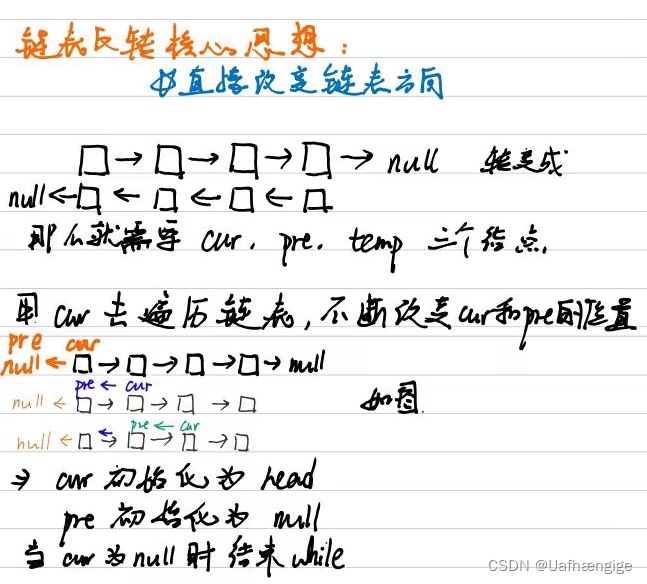算法练习DAY3 203.移除链表元素 206.反转链表 707.设计链表
203.移除链表元素
题目:给你一个链表的头节点 head 和一个整数 val ,请你删除链表中所有满足 Node.val == val 的节点,并返回 新的头节点 。
示例 1:
输入:head = [1,2,6,3,4,5,6], val = 6
输出:[1,2,3,4,5]
示例 2:
输入:head = [], val = 1
输出:[]
示例 3:
输入:head = [7,7,7,7], val = 7
输出:[]
链表定义:
public class ListNode {
int val;
ListNode next;
public ListNode() {
}
public ListNode(int val) {
this.val = val;
}
public ListNode(int val, ListNode next) {
this.val = val;
this.next = next;
}
}
本题其实就是遍历链表,移除目标元素,有几个细节需要注意:
1、head = null
2、head.val = val;
在写程序的时候不要漏掉这些情况
第一种:不使用虚拟节点
1、1判断首节点
//首先考虑head=null 如果为空就可以直接返回
if(head == null){
return head;
}
//判断head.val 是否等于 val
while (head.val == val){
head = head.next;
}
if(head == null){
return head;
}
显然这么考虑过于繁琐
改进:
while (head != null && head.val == val){ //这个时候已经确定head.val不会是目标值
head = head.next;
}
if(head == null){
return head;
}
1、2去除val值
这种写法会导致无法在 最后一个节点是val值 的情况下去除他 而且很繁琐
while (cur.next != null){
if(cur.val == val){
cur = cur.next;
}else {
pre.next = cur;
pre = pre.next;
cur = cur.next;
}
}//这种写法会导致无法在 最后一个节点是val值 的情况下去除他 而且很繁琐
卡哥:
思路:pre当成一个跳转节点
head开始的这条链表本身还在 我们要做的只是用cur这个引用去遍历链条
如果遍历到!=val 就让pre跟着cur走
如果==val 就跳过这个元素 (因为cur比pre快一个节点)
ListNode cur = head.next; //用于遍历的节点
ListNode pre = head; //感情的自然流露 需要一个节点
while (cur != null){
if(cur.val == val){
pre.next = cur.next;
}else{
pre = cur;
}
cur = cur.next;
}
public static ListNode removeElements1(ListNode head, int val) {
while (head != null && head.val == val) {
head = head.next;
}
// 已经为null,提前退出
if (head == null) {
return head;
}
// 已确定当前head.val != val
ListNode pre = head;
ListNode cur = head.next;
while (cur != null) {
if (cur.val == val) {
pre.next = cur.next;
} else {
pre = cur;
}
cur = cur.next;
}
return head;
}
第二种:使用虚拟节点 这样头节点就不需要特殊处理
/**
* 使用虚拟节点
*/
public static ListNode removeElements2(ListNode head, int val) {
if(head == null){
return head;
}
ListNode dummy = new ListNode(-1,head);
// 因为删除可能涉及到头节点,所以设置dummy节点,统一操作
ListNode cur = dummy.next;
ListNode pre = dummy;
while (cur != null){
if(cur.val == val){
pre.next = cur.next;
}else{
pre = cur;
}
cur = cur.next;
}
return dummy.next;
}
/**
*双指针法
* 核心思想:改变链表的指向
*/
public static ListNode reverseList(ListNode head) {
ListNode cur = head;
ListNode pre = null;
ListNode temp = null;
while (cur != null) {
temp = cur.next;
cur.next = pre;
pre = cur;
cur = temp;
}
return pre;
}
2、2递归法
public static ListNode reverseListD(ListNode head){
return reverse(head,null);
}
public static ListNode reverse(ListNode cur,ListNode pre){
if(cur == null){
return pre;
}
ListNode temp = cur.next;
cur.next = pre;
// 更新prev、cur位置
// prev = cur;
// cur = temp;
return reverse(temp,cur);
}
707.设计链表
设计链表的实现。您可以选择使用单链表或双链表。单链表中的节点应该具有两个属性:val 和 next。val 是当前节点的值,next 是指向下一个节点的指针/引用。如果要使用双向链表,则还需要一个属性 prev 以指示链表中的上一个节点。假设链表中的所有节点都是 0-index 的。
在链表类中实现这些功能:
get(index):获取链表中第 index 个节点的值。如果索引无效,则返回-1。
addAtHead(val):在链表的第一个元素之前添加一个值为 val 的节点。插入后,新节点将成为链表的第一个节点。
addAtTail(val):将值为 val 的节点追加到链表的最后一个元素。
addAtIndex(index,val):在链表中的第 index 个节点之前添加值为 val 的节点。如果 index 等于链表的长度,则该节点将附加到链表的末尾。如果 index 大于链表长度,则不会插入节点。如果index小于0,则在头部插入节点。
deleteAtIndex(index):如果索引 index 有效,则删除链表中的第 index 个节点。
示例:
MyLinkedList linkedList = new MyLinkedList();
linkedList.addAtHead(1);
linkedList.addAtTail(3);
linkedList.addAtIndex(1,2); //链表变为1-> 2-> 3
linkedList.get(1); //返回2
linkedList.deleteAtIndex(1); //现在链表是1-> 3
linkedList.get(1); //返回3
3、1单向链表
关于获取指定节点的函数
public int get(int index) { //获取指定下标的节点
//首先要考虑该节点是否存在
if(index < 0 || index > size){
return -1;
}
ListNode temp = head;
for (int i = 0; i <= index ; i++) {
temp = temp.next;
}
return temp.val;
/*for (int i = 0; i < index ; i++) {
int j = arr[i];
}
对于数组 上述写法最后的得到arr[index - 1];
单链表获得其实是当前i+1 最后也就是index+1
因为最前面有一个虚拟节点占着位置 所以需要index+1
*/
}
3、2双向链表(与单链表基本一致)

